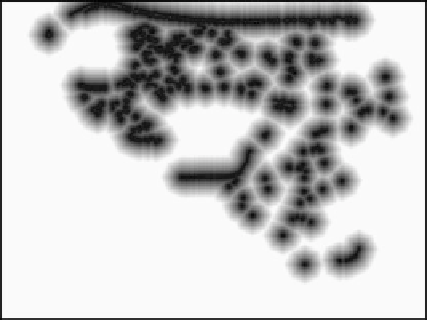Graphics Reference
In-Depth Information
Fig. 6.8
Distance-transformed edge
image of the door hinge
Ta b l e 6 . 3
Estimated pose
differences and ground truth
for the door hinge example
Parameter difference
Result
GT
ε
(
◦
) (roll)
4.15
4.23
λ
(
◦
) (pitch)
2.06
1.69
ρ
(
◦
) (yaw)
0.22
0.58
t
x
(mm)
0.71
0.06
t
y
(mm)
1.88
2.33
t
z
(mm)
3.82
0.16
attempt to perform a pose estimation of the hinge based on the extracted edge in-
formation. The surface of the hinge does not perceivably polarise the reflected light.
Hence, we only use intensity and defocus data as input information for our algo-
rithm. The obtained results illustrate that our algorithm also works in the absence of
some of the input cues and that it is suitable for pose estimation of objects with a
strongly specular surface.
In this experiment, the chequerboard method could not be used for determining
the ground truth, since the hinge could not be attached to the goniometer in a re-
produceable manner; it was not possible to place it in a known position relative to
the chequerboard and the goniometer. Similarly, the bundle adjustment tool based
on manually established point correspondences could not be used since, unlike the
oil cap, the hinge does not display well-defined corner points. Hence, the estimated
poses are compared with the difference imposed by the two chosen goniometer set-
tings, which are given at high accuracy. The estimated pose differences and the cor-
responding ground truth values are shown in Table
6.3
. Although not all geometric,
photometric, and depth cues are available, the obtained results are comparable to or
better than those obtained in the previous experiments (some tenths of a degree for
the rotation angles, some tenths of a millimetre for the lateral translation, and some
millimetres for the object distance).
The examined monocular pose estimation framework is based on photometric,
polarimetric, edge, and defocus cues. The pose is obtained by minimising a corre-



Search WWH ::

Custom Search